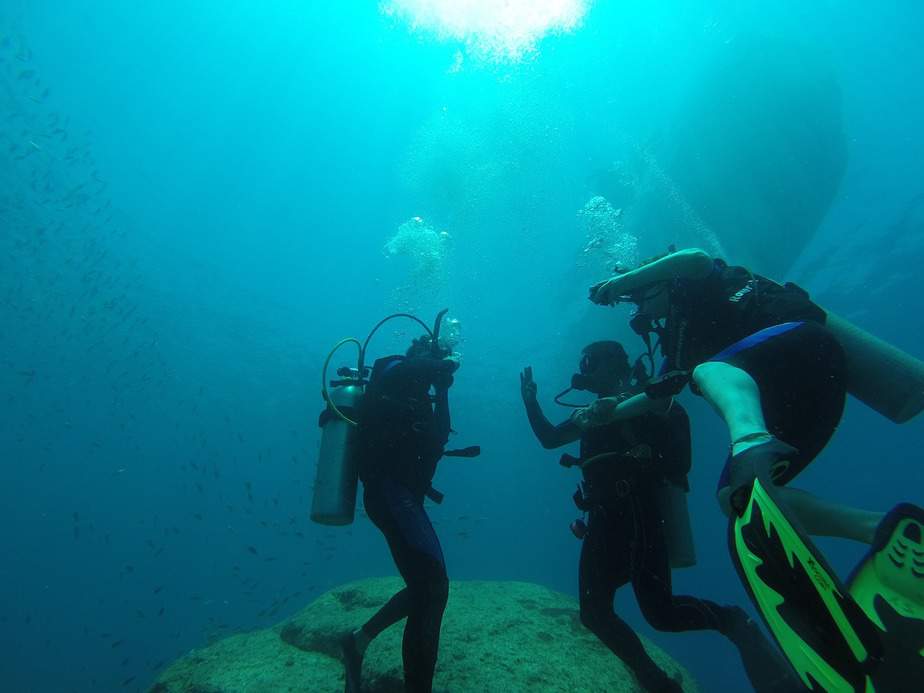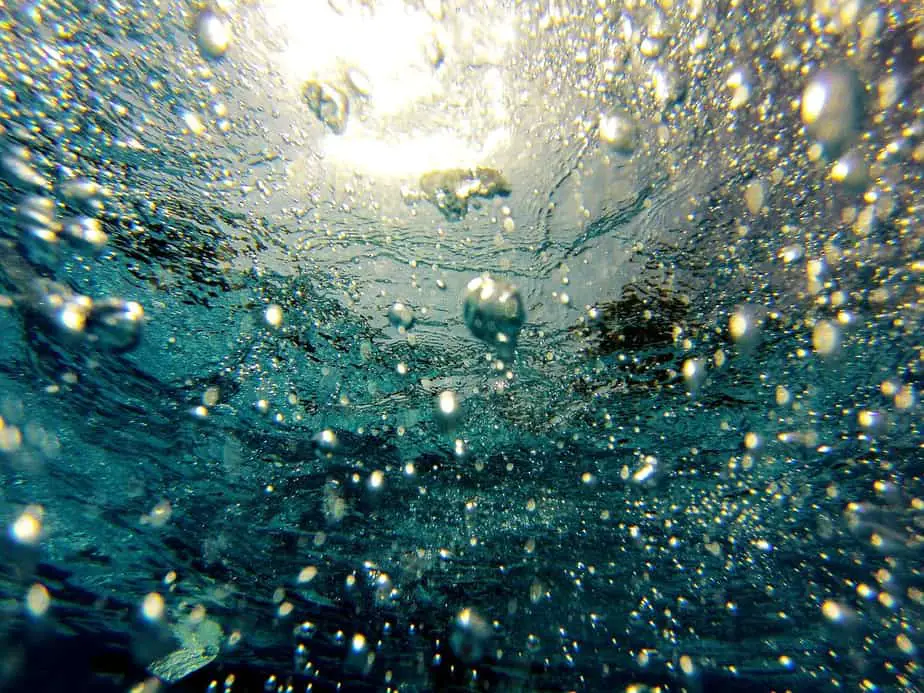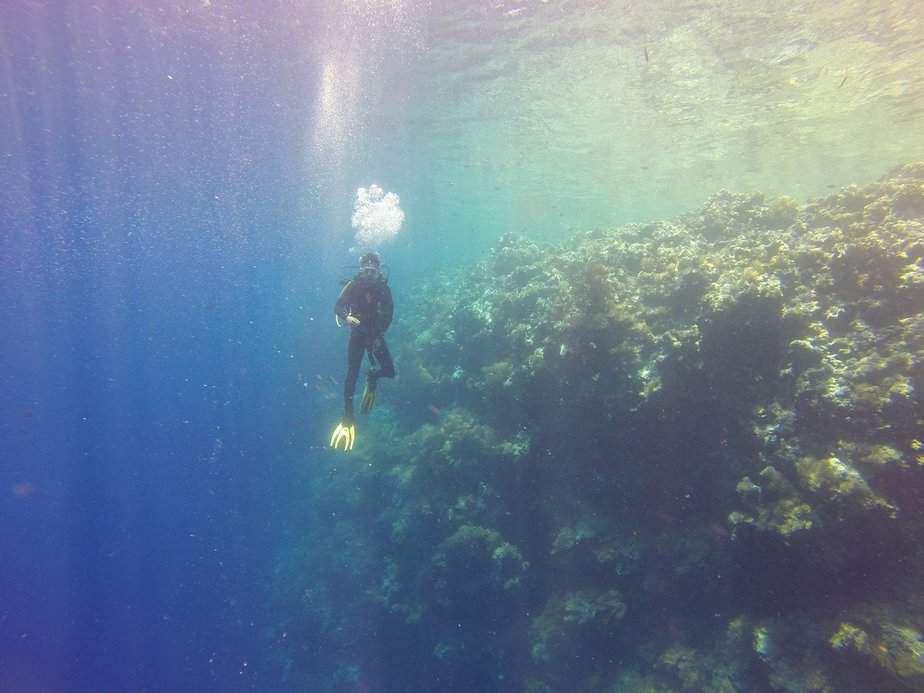Do you have a need for speed, even underwater? Perhaps you’re anxious to quickly reach the dive depth so you can have a longer bottom time. Or perhaps you’re afraid that you’ll run out of air while ascending within the recommended limits or during a safety stop. If you absolutely needed to ascend or descend quickly for whatever reason, what would happen to you?
If you’re newly scuba certified, then you should still remember how adamant your instructor was on ascending slowly lest you suffer the life-threatening effects of decompression sickness. So it’s clear you shouldn’t ascend quickly, but what about descending quickly? Are there any serious consequences for wanting to reach depth as fast as possible?
There is no fixed descent speed limit because that can change from dive to dive and person to person. Broadly speaking, descending fast can be dangerous because you may not have enough time to equalize your body which can result in severe barotrauma. You may also leave your dive buddy too far behind or descend too far past the depth you planned to dive at.
In order to be safe, you should limit your descent speed so that you have the most control of the situation. If a situation arises, such as problems with equalization or spotting danger, you will not plummet directly into it with no way to stop in time. In this article, we’ll discuss the dangers of descending too quickly, acceptable rates of descent, and how to properly descend while scuba diving.
Is it okay to descend quickly while diving?
There is a procedure you need to follow to ensure you’re safe while descending. You can descend as fast as you can perform the correct procedures, proper buddy techniques, and scout out the environment all while remaining in total control of your descent. If you descent too quickly, you run the risk of messing up these steps which can range from relatively minor to very serious.
Some of the most common problems that divers will experience if they descend too quickly are:
- Sinus, ear, and mask squeeze.
- Descending too far.
- Losing contact with your buddy.
- Descend directly onto danger (aquatic life, debris).
- Environmental damage.
- Overexertion.
Typically speaking, if your goal is to descend quickly, you can put yourself in a position where you lose control of your buoyancy which is never a good thing when scuba diving.
If you haven’t taken the Open Water Diver course yet, or need a refresher on how to safely descend, we highly recommend you review the standard 5-point procedure to help you perform all the necessary steps to ensure a safe descent. The next section describes this in more detail.
How to safely descend while scuba diving: SORTED
Depending on which agency you are training with, you will learn some variation of the 5-point procedure. It may seem unnecessarily complicated at first, but trust us, each step is important. With practice, you’ll be able to do all of these steps in your sleep. Experienced divers may do these steps informally while still covering all of the aspects needed.
Before a dive even begins, you must make sure to inflate your BCD until you are positively buoyant so that you can float along the surface without wasting your stamina. Once your buddy is also in the water and you’re both ready to dive, it’s time to begin the descent procedure.
An easy way to remember the steps you must do, as well as the order in which to do them, is to remember this acronym: SORTED. Let’s go over each step.
“S” – Signal
Communicate with your dive buddies that you’re ready to start the dive. This can be done with hand signals if you’re far away, or just by talking to them if they’re close enough.
“O” – Orientate
Next, orient yourself so that you can see the start point of the dive. Also look directly beneath you to ensure that you’re not about to descend into something dangerous.
Orienting yourself can be as simple as double-checking which section of the beach you’re starting from, or the name of your boat at a busy site, or taking a compass bearing. When checking beneath you, make sure there isn’t a shallow reef or other divers that you might crash into.
“R” – Regulator
Not all divers think a snorkel is necessary for scuba diving, so if you don’t have one with you then just move to the next step. If you’re wearing a snorkel, then this is the time to swap over to the regulator because your descent is imminent.
“T” – Time
Make a note of the dive’s start time on your dive watch or dive computer. This is crucial when running with dive tables. Since dive computers are so prevalent nowadays, this step is basically synonymous with inspecting your dive computer to ensure it’s functioning and ready to start tracking your dive.
“E” – Elevate, Exhale, Equalize
So that air can be let out of the BCD slowly, divers must elevate their inflator hose upwards so air can be vented out. Since the air in your lungs also contributes to your buoyancy, divers next need to exhale the air from their lungs so that they can begin their descent as the BCD empties as well.
As you descend and the water pressure increases, you will start to feel its effects on your mask, ears, and sinuses. Don’t wait until they start to hurt from the pressure to equalize. The adage is to equalize early and often.
“D” – Descend
While doing a controlled descent, keep a close eye on your dive buddy and frequently communicate using hand signals if you/they are okay. Continue to maintain focus on your depth, direction, and orientation.
As you descend, you have to slowly add some air back to your BCD to maintain control of your descent speed. The reason for this is that the air in your BCD is compressed due to the pressure, so more air is necessary to maintain neutral buoyancy.
How to descend while staying with your dive buddy

Unless you’re diving alone, it’s crucial to stay in constant contact with your dive buddy, especially during the descent. It’s easy to do this in tropical, clear waters because of the high visibility the location affords you. With that said, it’s still possible to lose sight of your buddy if you’re not paying attention.
Typically, divers should face toward their buddy while descending. You should still be looking all around you for spatial awareness, however you also need to balance this with looking over your dive buddy. Don’t get caught up in the excitement of what you’re going to do once you’ve reached depth, and instead focus on safely getting there with your buddy first.
Divers should be checking in on each other with hand signals and to signal if there’s a problem. It’s very common for some divers to have equalization problems, for instance, and they will take longer to descend. The slowest diver should be controlling the pace of the descent.
So if a diver can’t seem to equalize her ears, for example, then she should communicate to her buddy that she has a problem. Her buddy can then wait with them, or even ascend with them if it’s necessary, so that nobody is left behind. Never abandon your partner at any point during the dive, particularly while descending.
Is descending slowly the better option?
Almost always yes, because a diver will be in full control of their buoyancy, less likely to run into problems because they can see it coming, and better suited to deal with problems should they arise. If you’re a new diver with few dives under a belt, every descent should be slow until you get more experience.
Even advanced divers, when they are descending quickly, are still performing the proper steps. Since they are so experienced, they can do each step faster and therefore can do them more efficiently. Don’t skip steps or make a poor effort to follow them just so you can descend faster.
If you lose control, you can accidentally dive too deep which affects your NDL, or you can encounter problems like nitrogen narcosis. This is possible if you reach a depth you didn’t plan for with a gas mix that isn’t sufficient for that depth.
Are there benefits to descending quickly?
We have to stress that all divers in a group should move at the pace of the slowest diver. However, there are some circumstances where the divers try to descend “quickly” as long as they are still in control.
For instance, a quick descent may be desirable if the divers are making a deep dive to a specific target, such as a wreck. If the descent is unnecessarily long, they can use up a substantial portion of their gas supply or their no-decompression time, reducing their bottom time to explore the wreck.
Without skipping any safety procedures, a deep recreational diver should be planned out such that the divers can quickly and efficiently reach the target to maximize their bottom time.
What’s a good descent rate?
Unlike ascent rate, where the various scuba training agencies, dive computer manufacturers, and hyperbaric doctors have figured out a conservative range (9 to 18 meters per minute depending on which training agency you want to follow), there isn’t a similar recommendation for descent rate.
We’ve discussed already that the pace of a descent is limited by the slowest diver of the group, since divers must stick together in order to safely dive. Please be patient with this diver, particularly if they are new, as they try to follow the various steps of SORTED.
With experience, descents get faster because even the slowest diver will be faster, however there may be a physiological impact on people that forces them to slow down to safely equalize. One day you may be the slowest diver, in which case the descent rate for the group is the rate at which you descend.
Rapid descents vs. uncontrolled descents

A rapid descent is one where each diver is experienced and comfortable enough with the descending procedure that they can all descend together rapidly.
Sometimes inexperienced divers will perform an uncontrolled descent where they descend too quickly without much regard for equalization, buoyancy, buddy contact, or any other factors because they are out of control. This puts themselves, their dive buddies, and the environment in danger.
If you happen to be the slowest person in the group and feel like you’re holding everybody up, suck up your pride. It’s not as embarassing or as dangerous as doing an uncontrolled descent and needing to be rescued just because you wanted to go fast.
Descent Tips for New Divers
Get your dive weights right
You might be tempted to add an extra pound or two of lead weights to make descending easier, however the net effect is that it will make your dive much harder. Being overweighted seems like a good idea at first, but it brings a whole slew of problems that can be deadly.
Almost immediately after leaving the surface, divers will be subject to the water pressure. That means that the air in their lungs and scuba gear (i.e. BCD, air tank, wetsuit) will begin to compress, decreasing overall buoyancy. In other words, the deeper one descends, the more negatively buoyant they become unless they are counteracting it by inflating their BCD.
If a diver forgets this basic principle, then they will find themselves plummeting to the ocean depths because they are overweighted. In order to compensate for any extra weight, divers must inflate their BCD more, and there is a possibility that the BCD’s capacity may not be enough to keep the diver afloat.
Since it is hard to judge buoyancy and depth control, it can be hard to manage if you are overweighted. Equalization issues and overexertion also becomes a real issue for overweighted divers.
A correctly weighted diver should be able to maintain neutral buoyancy easily by making small adjustments. This will help them make a controlled descent, whereas an overweighted diver may find themselves descending uncontrollably.
To be safe, divers should make a pre-dive weight check, particularly if they are diving with new equipment or in freshwater when they usually dive in saltwater, etc. Furthermore, also factor in that your scuba cylinder will get more positively buoyant as gas gets used up.
Get yourself SORTED
Become proficient at the 5-point procedure to help you safely dive. It might seem too robotic and staged, and some divers end up just going through the motions or skipping steps altogether which is not a good idea.
The SORTED acronym is just a useful way to help you remember these vital steps. Don’t deviate from them until you gain more experience, and you’ll find that descending becomes a much smoother and natural process.
Always point your feet down while ascending or descending
You should descend and ascend in an upright position, with feet pointed down. It’s also important to be in this position while performing a safety stop. How come?
An upright position will give you more control over your vertical movement. Plus, when you’re properly weighted then being in a vertical position will evenly distribute the weight so that you’re neutrally buoyant. It may be hard to maintain a vertical position if there is an undercurrent, and beginner divers may need to use their hands and arms to make micro-adjustments to help them maintain their position.
Dive with someone you know
If you’ve got a real diving buddy, someone you know well and can trust to have your back, then it can make the process a lot smoother since you’ll know each other’s strengths and weaknesses.
Perhaps one of you has problems with equalization, and you can be there to help them out if necessary. You can remind each other if one of you is ascending or descending too quickly to slow down.
If everyone in your dive group are experienced divers who know each other, then you guys can descend with maximum efficiency. When diving with a stranger, both of you will be more cautious and move more slowly since you’re not familiar with each other’s habits.
Pay close attention to your dive computer or depth gauge
Particularly if the visibility is low, it can be difficult to judge your distance and descent rate. You should be regularly looking at your depth and your descent rate which your dive computer will calculate for you. If that number is too high, add more air into your BCD to slow your descent. Checking your depth often also ensures that you won’t accidentally dive too far.
Parting words
While you may feel antsy and want to quickly get underwater and enjoy diving as fast as possible, you still need to make sure that you’re following protocol to that everyone in the group is safe.
The pace at which you descend should be dependent on the speed of the slowest diver because you don’t want to leave anybody behind (that person might be you one day). If everyone in the group is experienced, then the descent speed can be controlled by you and your buddies.
However, it’s generally better to err on the side of caution by descending slowly. This ensures you are in total control of your buoyancy, equalization, and orientation. You also want to remain close to your dive buddy.
Overall, there is no fixed speed limit for descending, it can vary from dive to dive, and you should descend at a pace that the slowest diver in the group is comfortable with.


